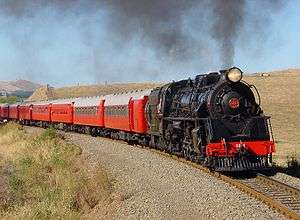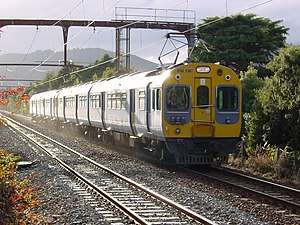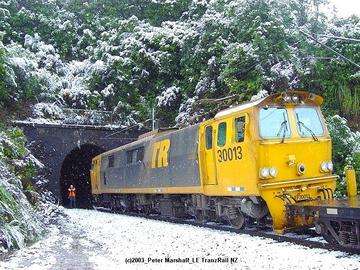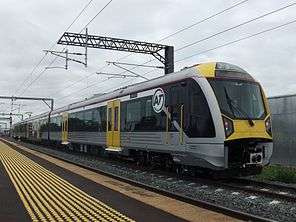Railway electrification in New Zealand
Railway electrification in New Zealand consists of three separate electric systems, all in the North Island. Electrification was initially adopted by the New Zealand Railways for long tunnels; the Otira Tunnel, the Lyttelton Rail Tunnel and the two Tawa Tunnels of the Tawa Flat Deviation. Electrification of Wellington suburban services started with the Johnsonville Line and Kapiti Line out of Wellington from the 1930s. Auckland suburban services were electrified in 2014–2015. Electrification of long-distance services on the North Island Main Trunk (NIMT) dates from 1986. New long tunnels, for example the Rimutaka Tunnel and the Kaimai Tunnel, were operated by diesels, and the Otira and Lyttelton Tunnels have converted to diesel operation.
| Part of a series on |
| Rail transport in New Zealand |
|---|
 |
From 1908 to 1953 there was an electrified mine railway from the Stockton mine on the West Coast of the South Island.
Earlier NZR electrified routes from 1923 to the 1940s operated at 1500 V DC, but the NIMT (1986) and Auckland suburban services (from 2014) use 25 kV AC; all with overhead catenary supply. The use of 16 kV AC (at 16.7 Hz) for the NIMT was proposed in 1950.
History
Stockton mine railway
The Stockton mine railway was, in 1908, New Zealand's first electric railway. It carried coal from the Westport-Stockton Coal Companies mine to the NZR railhead at Ngakawau on the West Coast of the South Island from 1908 to 1953, when it was replaced by an aerial cableway. The line was 10.5 km long, with 2.4 km in two long tunnels. The system used 275 V DC from a low overhead line via trolley poles, and 915 mm gauge track. The seven locos were of low built “mine” type.[1]
Otira and Lyttelton Tunnels
The first NZR line to be electrified in New Zealand was the Otira Tunnel in 1923. This long tunnel (8.55 km) with a steep gradient (1 in 33) could not have been worked by steam. In 1916 there was consideration of electrification of the entire 100 km section with steep grades from Jackson (West Coast) to Springfield (Canterbury), but in 1923 just the Otira-Arthur's Pass section (14 km) was electrified.[2]
In 1929 the Lyttelton Line through the Lyttelton Rail Tunnel was electrified. This tunnel (opened in 1867) was short and had a lesser gradient than Otira (0.3%) but replacement of steam operation was desirable.[3]
The Merz & McLellan Report
The 1925 report by the English consulting firm of Merz & McLellan was commissioned by the Minister of Railways Gordon Coates to investigate electrification of suburban services in the four main centres of Auckland, Wellington, Christchurch and Dunedin. For Christchurch it recommended electrification of the Lyttelton Line but not the main lines north and south. Now only Auckland and Wellington have suburban passenger services. The firm's partner Charles Merz of Newcastle upon Tyne had reported on Melbourne suburban electrification in 1908 and 1912.[4][5]
Wellington electrification
Several Wellington lines were then electrified: in 1938, the Johnsonville Line; and from 1940 the Kapiti Line section of the NIMT north of Wellington to Paekakariki through the two Tawa Tunnels which were part of the Tawa Flat Deviation. This line also had steep gradients (1 in 57) on the bank from Paremata up to Pukerua Bay.[6]

In February 1946 it was decided to electrify the remaining Wellington suburban lines to the Hutt Valley as there was a shortage of coal for locomotives, and also to replace commuter steam trains with EMUs, as the Hutt Valley was now largely residential with new state housing replacing market gardens. When the extra EMUs arrived in 1949 they were initially used for the Kapiti Line to Paekakariki while the Hutt Valley lines to Upper Hutt and Melling were electrified. So in the Hutt Valley, EMUs were supplemented in peak periods by older carriages hauled by electric locomotives until they were replaced by the Ganz-Mavag EMUs from 1986.[7]

The Johnsonville and Melling lines were short branch lines which were originally part of the main line (NIMT) north and the Hutt Valley line to the Wairarapa, until the lines replaced by deviations. The sections of these lines that were retained were mainly used for suburban commuter services, with initially some stock traffic to Johnsonville (later to Raroa).[8]
Dieselification
For two new long tunnels, diesel operation was more economic than a short electrified section; the Rimutaka Tunnel (1955) and the Kaimai Tunnel (1978). The Rimutaka Tunnel required an intermediate ventilation shaft. From 1967 diesel locomotives (DA class) replaced electric locomotives (EW class) on freight trains south of Paekakariki on the Kapiti Line after the track in some older tunnels was lowered, so diesels could run under the catenary into Wellington.
On two existing electrified tunnels the electrified section was only a small part of the total line. Hence the Lyttelton Rail Tunnel was operated by diesel locomotives from 19 September 1970. The Otira Tunnel was long and steep, so for dieselisation from 1997 a door and special ventilation fans were fitted (electrification of the whole 100 km Springfield to Jackson section with its steep gradients had been considered in 1916 and in the 1950s; possibly using 50 Hz AC not DC).
Electrification of the NIMT
In 1950 electrification of the entire North Island Main Trunk (NIMT) from Auckland to Paekakariki (the terminus of the Wellington electrification) was proposed by the General Manager F. W. Aickin, with 15 kV AC (at 16.7 Hz) to be used for the 657 route miles or 1,000 km of track. The system would have been operated at 16 kV AC, and would have been similar to the systems in Austria, Germany, Sweden, Switzerland and Norway; but has been superseded by 25 kV AC (at mains frequency, 50 or 60 Hz) for new systems.
The NIMT represented only 12% of the network length, but carried 40% of the system tonnage (13% more than the total South Island tonnage). A hundred Bo-Bo locomotives would be required, and in Auckland there would be suburban electric services to Henderson east of Auckland and to Papakura 34 km south of Auckland. A report by two Swedish engineers (Thelander and Edenius) was also obtained. Their report said electrification was a matter of necessity and estimated greater capital cost saving with AC electrification instead of DC (1500 V; or 3000 V as proposed by English Electric) than Aickin had allowed for. But the proposal was dropped in favour of dieselisation, with the first mainline DF class diesel locomotives arriving in 1954.[9][10][11]
In 1974 a study was undertaken to consider the looming problem of "traffic saturation" on the mountainous central section, particularly the Raurimu Spiral. In 1975 the study recommended electrification using 25 kV AC; but with a decline in traffic the proposal was dropped. In the late 1970s with the "oil shocks" of 1973 and 1979 the Third National Government embarked on several projects to reduce dependence on imported oil.[12]

Electrification of the 412-km centre section of the NIMT was one of the Think Big projects. The project was approved in December 1981; specifications were prepared in 1982 and tenders let in 1982–83. Other works improved the line by easing curves and gradients and replacing signalling. Work started in late 1984 and was completed in 1988 though on the 24 June rather than March as planned,[13] with an official train traversing the whole section. Brush Traction supplied 22 EF class locomotives; the design was scaled up to the Eurotunnel Class 9 locomotives supplied by Brush for the Channel Tunnel.[14]
In December 2016 KiwiRail announced that it proposed to dieselise this section of the NIMT due to the age of the present electric locomotives and the cost and time delays in changing locomotives at each end of the electrified section at Te Rapa and Palmerston North.[15][16][17][18][19] The decision was reversed in 2018.[20]
Electrification of the Auckland suburban network

The extensive suburban rail network around Auckland which had been operated by steam locomotives and then by diesel locomotives and railcars was electrified using 25 kV AC between April 2014 and July 2015. Electrification goes 34 kilometres (21 mi) south to Papakura, and there are no immediate plans to extend further south on the NIMT to Pukekohe or as far as Hamilton (the Waikato Connection and earlier Auckland-Hamilton passenger services have not succeeded). In 2020, the government announced funding to extend electrification from Papakura to Pukekohe.[21]
Existing systems
Auckland metro
All electrified lines in the Auckland metro area uses the 25 kV 50 Hz AC system.
The system is fed from Transpower's 220 kV grid at two locations: Penrose and Southdown
North Island Main Trunk
The North Island Main Trunk uses 25 kV 50 Hz AC. The system used is a 25-0-25 kV auto-transformer system, with autotransformers spaced along the line interconnecting the "positive" 25 kV contact line, earth, and the "negative" 25 kV feeder line.
The system is fed at four traction substations, taking power from Transpower's 220 kV national grid.
| Name | Location | Type | Notes |
|---|---|---|---|
| Bunnythorpe | 40.2841°S 175.6323°E | Feeder | |
| Tangiwai | 39.4640°S 175.5751°E | Feeder | |
| Taumarunui | 38.8892°S 175.3212°E | Feeder | |
| Hamilton | 37.7967°S 175.2660°E | Feeder |
Wellington metro
All electrified lines in the Wellington metro area use the 1500 V DC system.
- Johnsonville Line: completed 2 June 1938.
- Kapiti Line: Wellington Station to Paekakariki completed 1940; extended to Paraparaumu March 1983; extended to Waikanae 20 February 2011.
- Hutt Valley Line: Wellington Distant Junction to Taita completed 14 September 1953; extended to Upper Hutt 24 July 1955
- Melling Line: Hutt Valley Junction to Lower Hutt (Western Hutt) completed 23 September 1953; extended to Melling 1 March 1954.
The Wellington metro system is fed by 18 traction substations, taking power from Wellington Electricity's (Wellington metro) or Electra's (Kapiti Coast) 11 kV distribution networks. There are also a number of cross-tie substations, which do not feed electricity into the lines but perform switching functions.
| Name | Location | Notes |
|---|---|---|
| Epuni | 41.2074°S 174.9304°E | cross-tie substation |
| Glenside | 41.2018°S 174.8199°E | |
| Heretaunga | 41.1471°S 174.9910°E | cross-tie substation |
| Kaiwharawhara | 41.2532°S 174.8044°E | |
| Khandallah | 41.2428°S 174.7936°E | |
| Lindale | 40.8915°S 175.0300°E | |
| Lower Hutt | 41.2139°S 174.8871°E | |
| Mana | 41.0943°S 174.8678°E | |
| Ngaio | 41.2521°S 174.7707°E | |
| Ngauranga | cross-tie substation | |
| Paremata | 41.1234°S 174.8501°E | |
| Paekakariki | ||
| Petone | 41.2175°S 174.8804°E | |
| Pomare | 41.1718°S 174.9680°E | |
| Pukerua Bay | 41.0428°S 174.8837°E | |
| Raumati | 40.9367°S 174.9952°E | |
| Rocky Point | 41.2311°S 174.8413°E | cross-tie substation |
| Silverstream | 41.1471°S 174.9910°E | |
| Tawa | 41.1680°S 174.8289°E | cross-tie substation |
| Upper Hutt | 41.1276°S 175.0673°E | |
| Waikanae | ||
| Wellington | 41.2749°S 174.7841°E | |
| Woburn | 41.2201°S 174.9127°E |
Future
In 2008, a paper was produced by former New Zealand Rail senior managers Murray King and Francis Small,[22] on the extension of the NIMT 25 kV electrification from Te Rapa to Papakura and Hamilton to Tauranga.[22] The report put the total cost of electrification at $860 million, with $433 million for the Papakura-Te Rapa section.[22] It concluded that money would be better spent on grade and curvature easements, removing speed restrictions and increasing the length of passing loops.[22]
In 2012, Auckland Council commissioned a report into electrifying the railway from Papakura to Pukekohe. The project would be undertaken from 2021 to 2040.[23] The Labour Party and National Party both expressed support for the project during the 2017 general election.[24] The April 2018 Auckland Transport Alignment Project report recommended this project as a priority for the coming decade.[25]
References
- Churchman 1995, p. 8-9.
- Churchman 1995, pp. 10–15.
- Churchman 1995, pp. 16–19.
- Churchman 1995, p. 16.
- Pierre 1981, p. 185.
- Churchman 1995, pp. 20–29.
- Churchman 1995, pp. 30–36.
- Churchman 1995, pp. 20–24.
- Churchman 1995, pp. 37–38.
- Pierre 1981, pp. 242–247.
- Leitch & Stott 1988, pp. 103–107.
- Churchman 1995, p. 38.
- Tom McGavin (Autumn 1988). "North Island Main Trunk Electrified". New Zealand Railway Observer. New Zealand Railway and Locomotive Society. 45 no. 1 (194): 49. ISSN 0028-8624.
- Churchman 1995, pp. 39–41.
- "Kiwirail to dump electric trains and replace with diesel on NIMT". Stuff (Fairfax Media). 21 December 2016.
- "Editorial: ditching electric trains is shortsighted". Stuff (Fairfax Media). 17 January 2017.
- "Setback in Hamilton-Auckland commuter train dream, Greens say". Stuff (Fairfax Media). 1 July 2015.
- "Opinion: Dual-mode electric-diesel locos KiwiRails missing option". Stuff (Fairfax Media). 21 March 2017.
- "Kiwirail cost-saving plan nuts". Stuff (Fairfax Media). 28 March 2017.
- Tuesday; October 2018, 30; Zeal, 1:32 pm Press Release: New; Government. "Government saves electric trains | Scoop News". www.scoop.co.nz. Retrieved 20 January 2019.CS1 maint: numeric names: authors list (link)
- Jane Paterson (29 January 2020). "Govt's $12b infrastructure spend: Rail, roads and DHBs the big winners". Retrieved 29 January 2020.
- "EXTENSION OF ELECTRIFICATION – Benefits and Costs – Report to ONTRACK". Murray King and Francis Small Consulting. 2008. Cite journal requires
|journal=(help) - "Rail Electrification and Extension from Papakura to Pukekohe Updates" (PDF). Auckland Transport. February 2012.
- "Papakura to Pukekohe rail electrification". Australia and New Zealand Infrastructure Pipeline. 3 October 2018.
- "Auckland Transport Alignment Project 2018". Ministry of Transport (New Zealand).
Bibliography
- Churchman, Geoffrey B. (1995). Railway Electrification in Australia and New Zealand. Sydney & Wellington: IPL Books. ISBN 0-908876-79-3.CS1 maint: ref=harv (link)
- Stott, Bob; Leitch, David (1988). New Zealand Railways: The First 125 Years. Auckland: Heinemann Reed. ISBN 0-7900-0000-8.
- Sinclair, Roy (1987). Rail: The Great New Zealand Adventure. Wellington: Grantham House. pp. 86–91. ISBN 1-86934-013-2.
- Pierre, Bill (1981). North Island Main Trunk: An Illustrated History. Auckland: Reed. ISBN 0-589-01316-5.
- Redward, Roger (1974). Railway Electrification in New Zealand: An illustrated survey. Wellington: Southern Press.
- Pickering, A J; Spicer, I D (ed) (1970). Pioneer Electrics: A survey of railway electrification in the South Island:. Christchurch: Tramways Historical Society.CS1 maint: extra text: authors list (link)